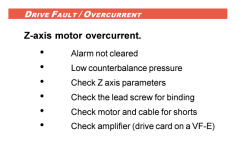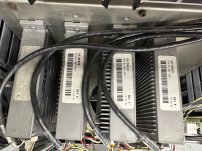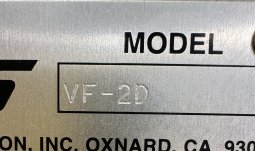ryan_unmanned
Plastic
- Joined
- Mar 12, 2023
Recently purchased a 2004 VF-2SS, was under power (208V) and running prepurchase. I had the seller install a 3.5" to USB upgrade then had the machine shipped about 200 miles to my shop. We had to wait on some panel upgrades, but finally last weekend got 240 run to the machine, switched over both the transformer (74/75/76) and voltage jumper to the upper limits (our voltage constantly measures ~246).
Booted up the machine, zero returned all axis, everything looks good. On Current Commands, X & Y are sitting at 0-2% load, Z is sitting at ~50%, figured this was just holding the head up. Went about doing other work (coolant, tooling, IDK), heard a noise (brake kicking on) turned around and had a 163 Z Axis Drive Fault error - Current is beyond limit. Head had dropped ~0.2" when the brake caught it. Hit reset, everything acts normally, can hand jog Z no problem. Look at Current Commands again, Z is sitting at ~60%. When I hand jog it, the Z is going all over the place from 60%-110%. I let it sit for a while, sure enough 15 min later same brake catch + 163 error. Power cycled the machine, same issue over and over.
Things I've checked:
From a 2002 manual (attached), think I can rule out:
Appreciate any help/feedback!
Booted up the machine, zero returned all axis, everything looks good. On Current Commands, X & Y are sitting at 0-2% load, Z is sitting at ~50%, figured this was just holding the head up. Went about doing other work (coolant, tooling, IDK), heard a noise (brake kicking on) turned around and had a 163 Z Axis Drive Fault error - Current is beyond limit. Head had dropped ~0.2" when the brake caught it. Hit reset, everything acts normally, can hand jog Z no problem. Look at Current Commands again, Z is sitting at ~60%. When I hand jog it, the Z is going all over the place from 60%-110%. I let it sit for a while, sure enough 15 min later same brake catch + 163 error. Power cycled the machine, same issue over and over.
Things I've checked:
- All servo amplifiers (not smart ones) have been lit green, even after the servo kicks off. Never a Red Fault light.
- Swapped A-axis with Z-axis amplifiers, Z-axis still fails to 163. Think this rules out the servo amplifier.
- Checked the Low Voltage pins on the MOCON board, everything was spot on.
- After one 163 kick-off, I powered everything down up to the breaker, climbed up and checked the servo temp by hand. About as warm as the bottom of a laptop, hot but not untouchable.
- When jogging the Z, no obvious sounds (groaning, etc.) to suggest its having a hard life.
From a 2002 manual (attached), think I can rule out:
- Alarm not cleared (duh)
- Low counterbalance pressure (no counter balance on my machine)
- Check motor and cable for shorts (no significant life change from when I bought it and it was running fine)
- Check Amplifier (done)
- Check z axis parameters - What are these? Where are these? What values should they be?
- Check the lead screw for binding - The machine was moved and leveled, could this be putting a bind on the lead screw? Would this manifest as a high current draw, that climbs until error out?
- Could the Floppy to USB upgrade be a problem? (Feels unlikely)
- Is this a problem running at 240V instead of 208? (Feels unlikely, transformer should make everything downstream unaware of the incoming voltage)
- Out of ideas
Appreciate any help/feedback!





